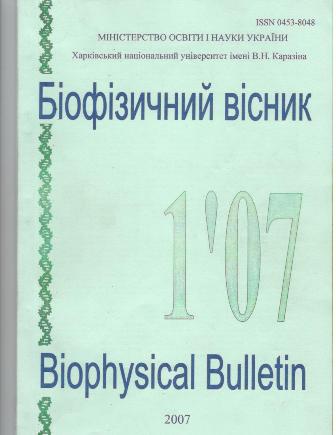Математичне моделювання ефектів ін’єкцій ГАМК у медулярні NO-синтезуючі кардіоваскулярні нейроні щурів
Ключові слова:
довгастий мозок щурів, NO-синтезуючі кардіоваскулярні нейрони, артеріальний тиск, моделювання
Анотація
Досліджено часову залежність змін системного артеріального тиску після ін’єкцій γ-аміномасляної кислоти (ГАМК) у кардіоваскулярні нейрони довгастого мозку щурів
Завантаження
##plugins.generic.usageStats.noStats##
Посилання
De Vente J, Hopkins DA, Maiierink-Van LM. Distribution of nitric oxide synthase and nitric oxide receptive cyclic GMP-producing structures in the rat brain. Neuroscience. 1998;87:207-41
Gai WP, Messenger JP, Iu YH. Nitric oxide-synthasizing neurons in the central nervous subnucleus of the nucleus tractus solitarius provide a major innervation of the rostral nucleus ambiguus in the rabbit. J.Comp.Neurol. 1995;357:348-61.
Vincent SR, Kimura H. Histochemical mapping of nitric oxide synthase in the rat brain. Neuroscience. 1992;46:755-84.
Zanzinger J, Czachurski J, Seller H. Effects of nitric oxide on sympathetic baroreflex transmission in the nucleus tractus solitarii and caudal ventrolateral medulla in cats. Ibid. 1995;197:199-202.
Sakai K, Hirooka Y, Matsuo I. Overexpression of eNOS in NTS causes hypotension and bradycardia in vivo. Hypertension. 2000;36:1023-8.
Paxinos G, Watson C. The rat brain in stereotaxic coordinates. N.J.:Academic Press; 1982. p. 83.
Shapoval LM,Sagpch VF, Pobigailo SS, Stepanenko LG, Ermolinska NV. Rol oksydu azotu v realizatcii efektyv intrabulbarno vvedenoii y-aminomaslianoii kysloty na systemu krovoobigu. Fiziol.zhurn. 2005;51(1):43-50. (in Ukrainian)
Amano M, Kubo T. Involvement of both GAB Aa and GABAb receptors in tonic inhibitory control of blood pressure at rostral ventrolateral medulla of the rat. Naunyn Schemiedebergs Arch. Pharnacol. 1993;348:146-53
Blessing WW. Depressor neurones in rabbit caudal medulla act via GABA receptors in rostral medulla. Amer. J. Physiol. 1988;23:H786-92
Kagiyama S, Tsuchihashi T, Abe I, Fujishima M. Cardiovascular effects of nitric oxide in the rostral ventrolateral medulla of rats. Brain Res. 1997;757:155-158.
Meeley MP, Ruggiero DA, Ishitsuka T, Reis DJ. Intrinsic g-aminobutyric acid neurons in the nucleus of the solitary tract and rostral ventrolateral medulla of the rat: immunocytochemical and biological study. Neurosci.Lett. 1985;58:83-9.
Martins-Pinge MC, Baraldi-Passy I, Lopes OU. Excitatory effects of nitric oxide within the rostral ventrolateral medulla of freely moving rats. Hypertension. 1997;30:704-7.
Ying JP, Qian LG, Peng LL. GABa receptors in the rostral ventrolateral medulla mediate the depressor response induced by stimulation of the greater aplanchnic nerve afferent fibres in rats. Neurosci. Lett. 1998;249:95-8.
Kishi T, Hirooka Y, Sakai K. Overexpression of eNOS in the RVLM causes hypertension and drady-cardia via GABA release. Hypertension. 2001;38:896-904.
Gai WP, Messenger JP, Iu YH. Nitric oxide-synthasizing neurons in the central nervous subnucleus of the nucleus tractus solitarius provide a major innervation of the rostral nucleus ambiguus in the rabbit. J.Comp.Neurol. 1995;357:348-61.
Vincent SR, Kimura H. Histochemical mapping of nitric oxide synthase in the rat brain. Neuroscience. 1992;46:755-84.
Zanzinger J, Czachurski J, Seller H. Effects of nitric oxide on sympathetic baroreflex transmission in the nucleus tractus solitarii and caudal ventrolateral medulla in cats. Ibid. 1995;197:199-202.
Sakai K, Hirooka Y, Matsuo I. Overexpression of eNOS in NTS causes hypotension and bradycardia in vivo. Hypertension. 2000;36:1023-8.
Paxinos G, Watson C. The rat brain in stereotaxic coordinates. N.J.:Academic Press; 1982. p. 83.
Shapoval LM,Sagpch VF, Pobigailo SS, Stepanenko LG, Ermolinska NV. Rol oksydu azotu v realizatcii efektyv intrabulbarno vvedenoii y-aminomaslianoii kysloty na systemu krovoobigu. Fiziol.zhurn. 2005;51(1):43-50. (in Ukrainian)
Amano M, Kubo T. Involvement of both GAB Aa and GABAb receptors in tonic inhibitory control of blood pressure at rostral ventrolateral medulla of the rat. Naunyn Schemiedebergs Arch. Pharnacol. 1993;348:146-53
Blessing WW. Depressor neurones in rabbit caudal medulla act via GABA receptors in rostral medulla. Amer. J. Physiol. 1988;23:H786-92
Kagiyama S, Tsuchihashi T, Abe I, Fujishima M. Cardiovascular effects of nitric oxide in the rostral ventrolateral medulla of rats. Brain Res. 1997;757:155-158.
Meeley MP, Ruggiero DA, Ishitsuka T, Reis DJ. Intrinsic g-aminobutyric acid neurons in the nucleus of the solitary tract and rostral ventrolateral medulla of the rat: immunocytochemical and biological study. Neurosci.Lett. 1985;58:83-9.
Martins-Pinge MC, Baraldi-Passy I, Lopes OU. Excitatory effects of nitric oxide within the rostral ventrolateral medulla of freely moving rats. Hypertension. 1997;30:704-7.
Ying JP, Qian LG, Peng LL. GABa receptors in the rostral ventrolateral medulla mediate the depressor response induced by stimulation of the greater aplanchnic nerve afferent fibres in rats. Neurosci. Lett. 1998;249:95-8.
Kishi T, Hirooka Y, Sakai K. Overexpression of eNOS in the RVLM causes hypertension and drady-cardia via GABA release. Hypertension. 2001;38:896-904.
Опубліковано
2007-06-05
Цитовано
Як цитувати
Radchenko, N. V., Shapoval, L. M., Davydovska, T. L., & Prylutskyy, Y. I. (2007). Математичне моделювання ефектів ін’єкцій ГАМК у медулярні NO-синтезуючі кардіоваскулярні нейроні щурів. Біофізичний вісник, 1(18), 69-72. вилучено із https://periodicals.karazin.ua/biophysvisnyk/article/view/12624
Розділ
Біофізика складних систем
Авторське право (c) 2007 Біофізичний вісник
Автори, які публікуються у цьому журналі, погоджуються з наступними умовами:
- Автори залишають за собою право на авторство своєї роботи та передають журналу право першої публікації цієї роботи на умовах ліцензії Creative Commons Attribution License, котра дозволяє іншим особам вільно розповсюджувати опубліковану роботу з обов'язковим посиланням на авторів оригінальної роботи та першу публікацію роботи у цьому журналі.
- Автори мають право укладати самостійні додаткові угоди щодо неексклюзивного розповсюдження роботи у тому вигляді, в якому вона була опублікована цим журналом (наприклад, розміщувати роботу в електронному сховищі установи або публікувати у складі монографії), за умови збереження посилання на першу публікацію роботи у цьому журналі.
- Політика журналу дозволяє і заохочує розміщення авторами в мережі Інтернет (наприклад, у сховищах установ або на особистих веб-сайтах) рукопису роботи, як до подання цього рукопису до редакції, так і під час його редакційного опрацювання, оскільки це сприяє виникненню продуктивної наукової дискусії та позитивно позначається на оперативності та динаміці цитування опублікованої роботи (див. The Effect of Open Access).





